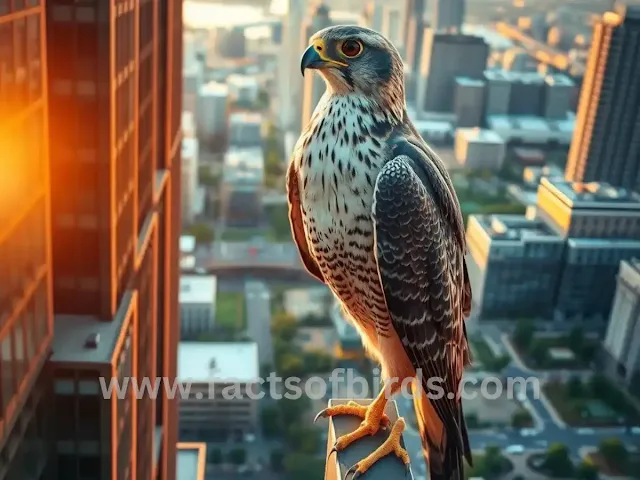City Raptors: Spotting Birds of Prey in Urban Areas
Birds of prey, or raptors, are no longer confined to the wilderness. Increasingly, these majestic hunters are thriving in urban areas, adapting to the concrete jungles and providing urban birding enthusiasts with thrilling opportunities to witness their behavior up close. In this article, we’ll explore the phenomenon of raptors in cities, highlight how to spot them and delve into their ecological significance.
Why Are Birds of Prey Thriving in Urban Areas?
Urban areas offer unexpected advantages for birds of prey. Cities provide ample food sources, from small mammals to abundant pigeon populations, and tall buildings mimic cliffs, offering perfect nesting spots. Furthermore, raptors often find refuge in cities from natural predators and human hunters who are less common in urban settings.
Species like peregrine falcons, red-tailed hawks, and even owls have taken to urban living, demonstrating remarkable adaptability. Their success in these environments underscores their intelligence and ability to capitalize on new opportunities.Common Raptors Found in Cities
Many birds of prey have become urban dwellers, each with unique traits and behaviors. Some of the most commonly spotted raptors include:- Peregrine Falcons: Known for their incredible speed, these birds often nest on skyscrapers, using their height to hunt efficiently.
- Red-Tailed Hawks: These adaptable hunters thrive in parks, golf courses, and other open urban spaces.
- Barn Owls: Often seen in industrial areas or near abandoned buildings, barn owls contribute to rodent control in cities.
Best Locations for Urban Birding
Birds of prey in urban areas are often found in specific environments. To enhance your urban birding experience, focus on these hotspots:- Parks and Green Spaces: City parks offer a haven for raptors, with trees for perching and small mammals as prey. Look for red-tailed hawks circling overhead or owls roosting in secluded spots.
- Tall Buildings and Bridges: Peregrine falcons often use skyscrapers and bridges as substitutes for cliffs. Early mornings are a great time to see them hunting pigeons or other birds.
- Industrial Areas and Rooftops: In quieter industrial zones, kestrels and owls may take advantage of the lower human activity to hunt rodents and establish nests.
Tips for Spotting Raptors in Urban Areas
Observing birds of prey in cities requires patience and attention to detail. Here are some key strategies to improve your chances:
- Look Up: Raptors are often seen soaring high in the sky, perched on ledges, or roosting in tall trees.
- Listen Closely: Learn to identify raptor calls, as their unique vocalizations can help you locate them.
- Use Binoculars: A good pair of binoculars enhances your ability to spot raptors from a distance.
- Go Early or Late: Dawn and dusk are prime hunting times for many raptors, making them more active and visible.
The Role of Raptors in Urban Ecosystems
Raptors play a crucial role in maintaining the ecological balance of urban areas. By preying on rodents, pigeons, and other small animals, they help control populations that could otherwise grow unchecked. Their presence also signifies a healthy urban ecosystem, indicating sufficient food and nesting sites.
How to Attract Raptors to Urban Green Spaces
Creating a raptor-friendly environment in urban green spaces not only benefits the birds but also enriches the local ecosystem. Here’s how you can encourage raptors to visit your area:
- Install Nesting Platforms: Tall structures with secure perches attract raptors like hawks and kestrels.
- Avoid Pesticides: By maintaining pesticide-free zones, you ensure a steady supply of prey for raptors.
- Plant Native Vegetation: Native plants attract insects, which in turn support the food chain leading to raptors.
The Challenges Raptors Face in Urban Areas
Despite their adaptability, raptors in urban areas face numerous challenges:
- Collisions with Glass: Skyscrapers and reflective windows pose significant risks to flying raptors.
- Pollution and Contaminants: Pesticides and rodenticides can harm raptors through secondary poisoning.
- Human Disturbance: Noise, light pollution, and human activity can disrupt their natural behaviors.
Fascinating Facts About Urban Raptors
Urban birds of prey often exhibit unique behaviors and adaptations. Consider these remarkable traits:
- Peregrine falcons have been recorded reaching speeds of over 240 mph during dives in cityscapes.
- Some raptors, like kestrels, use artificial lights at night to hunt more effectively, spotting prey in illuminated areas.
- Cities with strong raptor populations often experience reduced numbers of invasive species, showcasing their ecological impact.
Conclusion: Embrace the Thrill of Urban Birding
City raptors are a testament to nature’s resilience and adaptability. By understanding where and how to spot these birds of prey in urban areas, you can deepen your appreciation for their role in city ecosystems. Whether you’re a seasoned urban birder or a curious newcomer, witnessing these majestic hunters in action is a thrilling reminder of the wild world thriving amidst the concrete jungle.
Keep your binoculars handy, and let urban birding be your gateway to discovering the incredible lives of birds of prey in your city!

.webp)